Investor News
Is Victoria's energy plan a leap of faith?
According to a recent article ($) by Angela Macdonald-Smith and Aaron Patrick in the Fin Review, EnergyAustralia Managing Director and a Director of the Reserve Bank of Australia, Catherine Tanna believes the Victorian government's 'aggressive' wind and solar push is a 'leap of faith' that could send electricity prices skyrocketing more than they already have while risking grid stability and reliability.
In this newswire we look at:
- Victorian energy policy consultation
- The energy trilemma and the huge jump in wholesale electricity and gas
- Lessons from the closure of the Hazelwood power station
- The (un)reliability of energy system modeling
- Why wind and solar aren't cheaper than new brown coal (with Coldry).
Victorian Energy Policy Consultation
The Victorian government is consulting on interim emissions targets for 32 to 39 percent reductions by 2025 from 2005 levels, and 45 to 60 percent reductions by 2030 based on half the state’s electricity being generated by renewables.
On August 13 Victorian Energy Minister Lily D’Ambrosio introduced a 50 percent renewable energy target into the parliament claiming it will lower the cost of power and reduce CO2 emissions while creating jobs.
EnergyAustralia, in its submission to government, stated:
“Our concern is that any closure of Yallourn, or of any other power station, must be done without the risk of power outages, while assuring electricity remains affordable to Victorian homes and businesses.”
“Without a bottom-up assessment of this nature and careful planning, it is a leap of faith, the risk of which will be borne by all Victorians, but most acutely the residents of the Latrobe Valley,”
Minister Lily D’Ambrosio has denied the government plans to force coal power plants to close, but Ms Tanna is concerned the plan will force EnergyAustralia's Yallourn power station to close earlier than scheduled, triggering another price shock like the one that followed the unplanned closure of Hazelwood brown coal-fired power station in 2017.
What's the problem?
Wholesale electricity prices have jumped 230% since 2016:
And gas prices have increased by 225% since 2016:
Many factors influence prices, such as gas export parity pricing and embargos on gas exploration.
But, at the core of the issue is the concept of the energy trilemma: affordable, reliable, low-emissions... pick any two.

Who should we believe when it comes to the likely impacts of an energy policy that mandates more wind and solar; the government or Ms Tanner?
Both could be accused of bias. So how do we adjudicate?
Luckily, there is precedent and data to inform our views.
The Hazelwood experience
On 3 November 2016 Engie, owner of the Hazelwood power station, announced its early closure by March 2017.
The Victorian government didn't force this to happen. At least, not directly.
Engie cited 'commercial reasons'. But this wasn't long after the state government tripled the brown coal mining tax.
Losing a quarter of the state's electricity capacity was always going to have an impact, as the AER would later confirm. It was just a question of 'how much?'
But this is not how the government presented the situation at the time.
The Victorian Premier, Dan Andrews called the fear of drastic cost increases of 25% 'wild and inaccurate', claiming instead that the impact on bills would be in the order of 4% or 85 cents per week (link) in 2017.
Energy Minister Lily D'Ambrosio echoed the position.
What informed their position?
Their view was based on analysis by energy economist Bruce Mountain of Carbon + Energy Markets. Mountain forecast minimal impact, including an absolute decline in the total electricity bill and little change in the wholesale component:

So, how did prices actually play out?
A year later (March 2018) the data was in. Rather than a 4% increase, the closure resulted in a 16% increase in retail electricity bills. Sure, not 25% as some feared but still 400% higher than the 4% quoted by the government.
But how did the expert get the forecast so wrong?
Simply, the governing principle when forecasting is; garbage-in, garbage-out.
The prediction is only as good as the assumptions.
Where did the assumptions go wrong?
The answer seems to lie within the assumptions underpinning the 'bill stack' shown above. As you can see, the wholesale component was forecast to stay relatively unchanged at less than $200 a year. This is for a 'standard' annual household electricity bill, based on 3850kWh, which translates to about $52 per MWh. And sure enough, AEMO data confirms this to be a reasonable ballpark figure at the time.
But, rather than the nice steady wholesale price forecast through 2017 and 2018, it more than doubled:
It's not the first time an 'expert' has got modeling wrong, but a 400% margin of error should prompt us to ask questions like; why did prices jump so much?
Fortunately, this question is addressed in this report from the Australian Energy Regulator (AER), a year after the closure of Hazelwood.
The report found:
"... that price increases associated with the need to replace Hazelwood’s output aligned with expectations."
If this was the expectation of the AER, why was it not also the expectation of Bruce Mountain, Dan Andrews and Lilly D'Ambrosio?
The AER report further notes that:
“The replacement of Hazelwood’s low cost brown coal generation by higher cost black coal, gas and hydro generation – coinciding with rising black coal and gas fuel prices during the period – was found to be the underlying driver of the wholesale price increases,”
Paula Conboy, AER Chair
EnergyAustralia Managing Director Catherine Tanner has made her position on the likely impact of the 50% renewable energy mandate clear to the Victorian Government; potential early closure. And we've seen what happens to affordability and reliability under such circumstances.
Further, Ms Tanner states:
“Without a bottom-up assessment of this nature and careful planning, it is a leap of faith, the risk of which will be borne by all Victorians, but most acutely the residents of the Latrobe Valley,”
Unfortunately, the Victorian government isn't open to such a bottom-up assessment. And the only reason you avoid such due diligence is if you know the outcome won't support your agenda.
The direct problem raised by Ms Tanner is being ignored. Instead, an alternative report has been released by the Government in an effort to show how financially beneficial the 50% target will be.
But, knowing that a forecast is only as good as its assumptions, can we rely on this one?
Firstly, the report neither assumes nor considers the impact of an early exit of Yallorn power station, so it ignores the Hazelwood experience.
And as an indication of the potential reliability of the report's assumptions, this chart from page 9 shows the modeling to already be wrong:

Even now, as we're 3 months into the financial year the 2020 wholesale price is sitting around $98, or 20% higher than that chart projects. Over the coming months, the ASX futures for electricity prices indicate the wholesale price in Victoria will stay above $85.
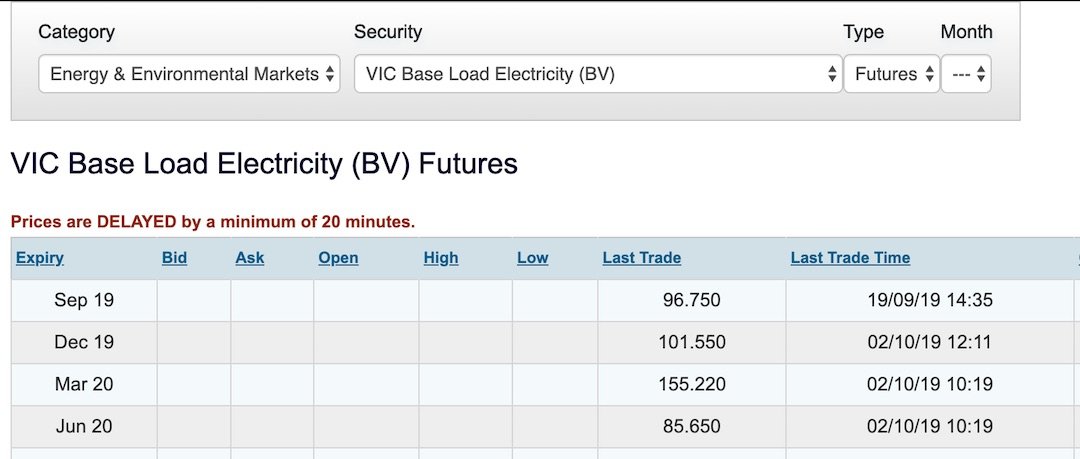
Immediately, the government forecast is off, suggesting another 'Hazelwood experience' is on the way.
Can more wind and solar bring down electricity prices?
Is the failure of 'expert' forecasts - declining energy prices in the face of rising wind and solar penetration - just a local quirk driven by other possible local market factors, or structural barriers like an 'outdated' grid?
Unfortunately not.
Internationally, the data confirms the trend that increased wind and solar penetration correlate with higher electricity prices:

This trend holds when we drill down to Victoria's data over the past decade:
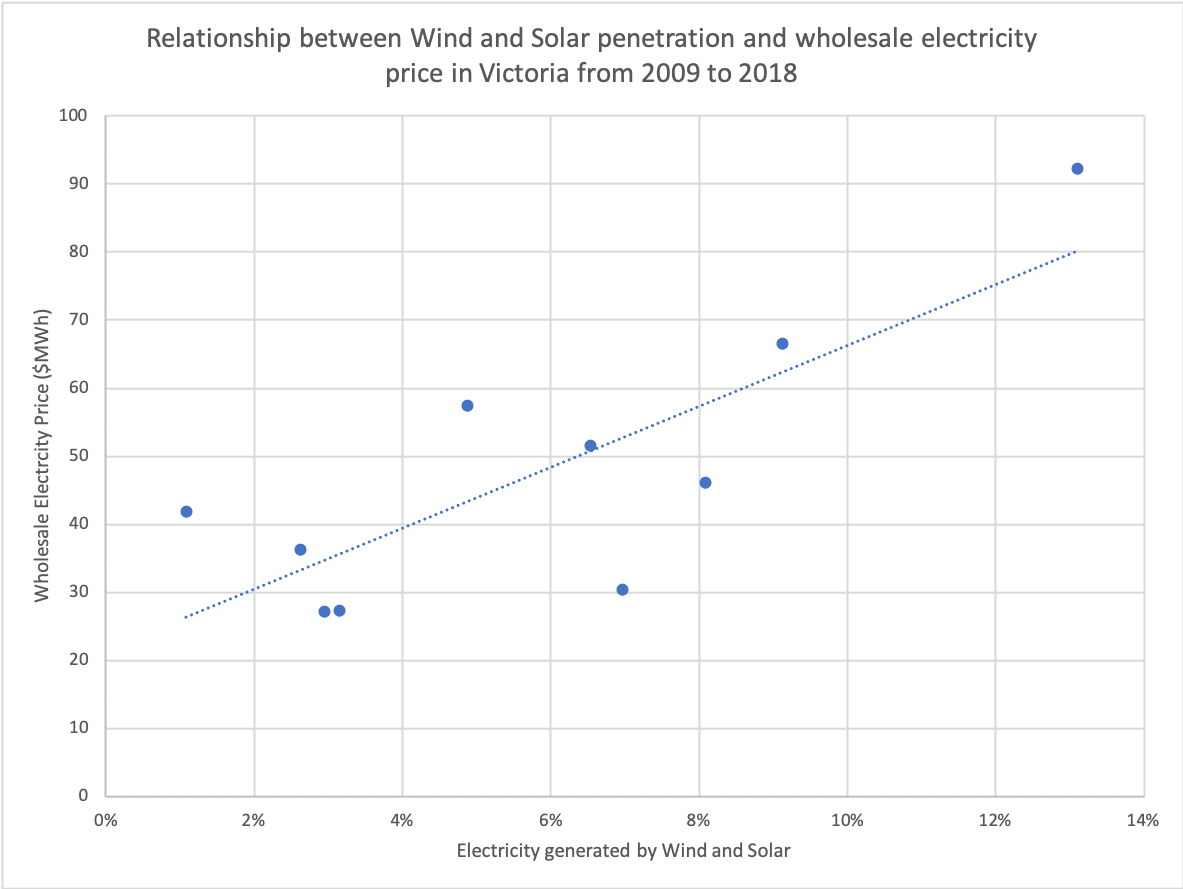
But aren't wind and solar now cheaper than coal?
This is certainly the narrative put forward by the CSIRO (and others):
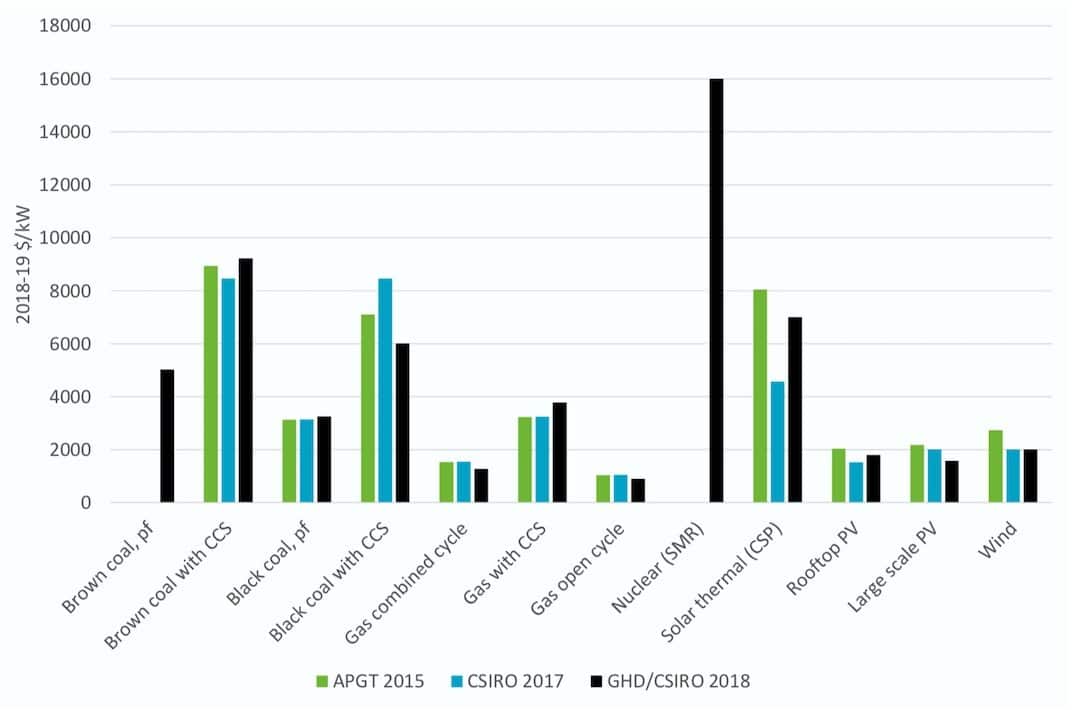
The above chart shows new brown coal power generation to be two and a half times the capital cost of new wind and solar.
And AEMO tells us there's an additional 2,025MW of Wind and 386MW of utility-scale solar due to rollout in Victoria. That's more than the 1,480 MW capacity of Yallourn that could be 'lost'.
On face value, adding new wind and solar appear to be a 'no-brainer' when it comes to replacing brown coal-based generation.
But.
A deeper dive into the narrative unearths several questions on why certain assumptions have been used.
Let's start with...
Capacity Factor & Storage
Ignoring 'capacity factor' is one of the great 'omissions' by wind and solar advocates when talking about the cost of wind and solar.
'Storage' is the other significant 'omission'.
The other 'mistake' is overestimating the 'capacity factor' or underestimating the 'storage' requirement when they are mentioned.
For those unfamiliar with the concept of 'capacity factor', it is simply the ratio of actual electrical energy output over a given period of time to the maximum possible electrical energy output over that period.
'Storage' is required to make intermittent wind and solar reliable.
The average 'capacity factor' for wind is around 30%.
For small scale rooftop installations, it's 20% and 25% for utility-scale plants.
The output profile of wind is different to solar, so their respective capacity factors have a different profile, impact on supply and storage requirements.
Individual wind turbines can vary between 0% and 100% and change within minutes. Collectively, wind farms rarely hit 0% but they certainly can create holes in supply:

For the period above, wind averaged 35%, with a low of 11% and a high of 54%.
Solar varies between 0% and about 65%, with less volatility than wind on short timescales.
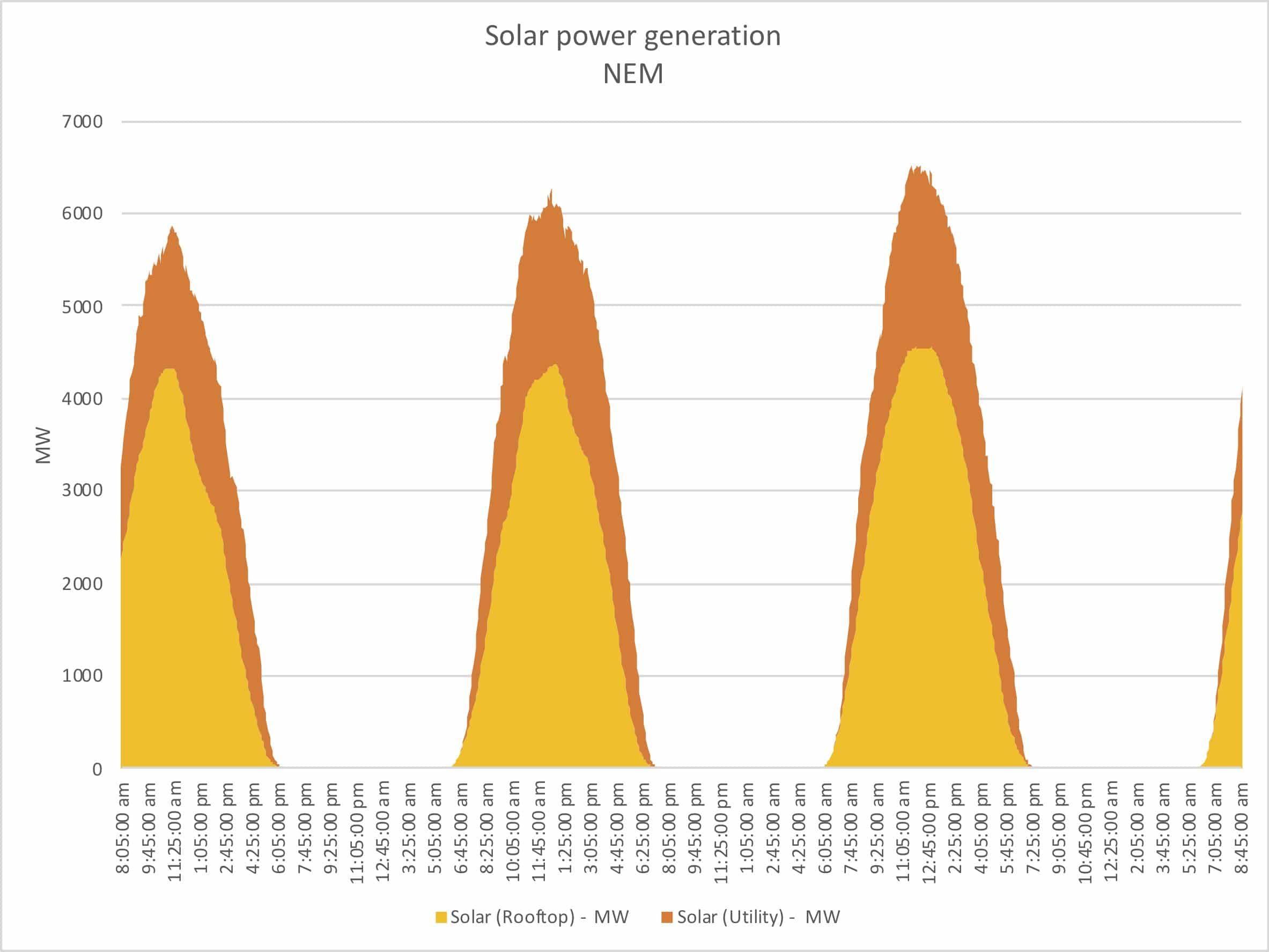
Solar has the benefit of being more predictable and constant than wind but has the downside of ceasing output completely overnight.
Returning to the CSIRO chart, it's important to understand the impact that overestimating the 'capacity factor' can have on cost estimates.
And, as we've learned, assumptions are crucial to forecast accuracy.
The first thing to note is the report uses a 'capacity factor' of 44% for wind and 32% for solar (link) where the historical averages are 30% and 20%-25% for wind and solar, respectively.
Assuming a capacity factor of 44% results in the levelised cost of electricity (LCOE) for wind being ~$61MWh, without storage.
Applying the actual capacity factor of 30% means the LCOE for wind is ~$90MWh, without storage.
A big difference!
Diving into all the assumptions is a huge exercise in itself and beyond this article, but suffice to say the assumptions have been 'gamed'. They are overly generous for wind and solar and overly punitive for brown coal.
Replacing Yallourn power station with dispatchable wind and solar
So, what does the real picture look like?
Let's consider replacing Yallourn power station, which has an annual output of 10,500GWh, with a combination of wind, solar and storage.
The Australian Renewable Energy Agency (ARENA) has looked at what it takes to make wind and solar dispatchable, quoting wind or solar (utility-scale) on their own at $63MWh and $68MWh, respectively (again, with overly generous 'capacity factor' assumptions).
Application of real-world capacity factors changes that to $93MWh and $98MWh, respectively.
The CSIRO suggests a storage level of half a day's average demand to 'firm' intermittent sources via load shifting with an optimum mix of wind and solar being around 55:45. We can use these as the starting point to understand how much wind and solar may be required to replace Yallourn's output.
Yallourn generates 10,500GWh a year. That's an average of 28GWh a day, requiring storage capacity of 14GWh.
We can look at what it may take to replace Yallourn either as a load-following scenario or a baseload scenario.
Load Following

- New wind capacity - 2,220MW
- New Solar PV capacity - 2,175MW
- Total new capacity - 4,395MW
- Average output per day - 28,000MWh
- New storage energy capacity - 14,000MWh
- New storage power capacity - 860MW
The chart above is only an indicative look at what would be required using the demand profile from a couple of typical days. Both wind and solar resources are based on reasonable conditions. There's no cherrypicking of lowball data.
In terms of storage, pumped hydro has been chosen because batteries would be too expensive. In reality, there may be a small battery component, but it's left out here to keep the 'storage' cost down.
The above scenario results in a levelised cost of ~$105MWh. And that's without generator margin.
Baseload
What if we wanted to match the original profile of Yallorn and provide steady baseload?
It would look something like this:
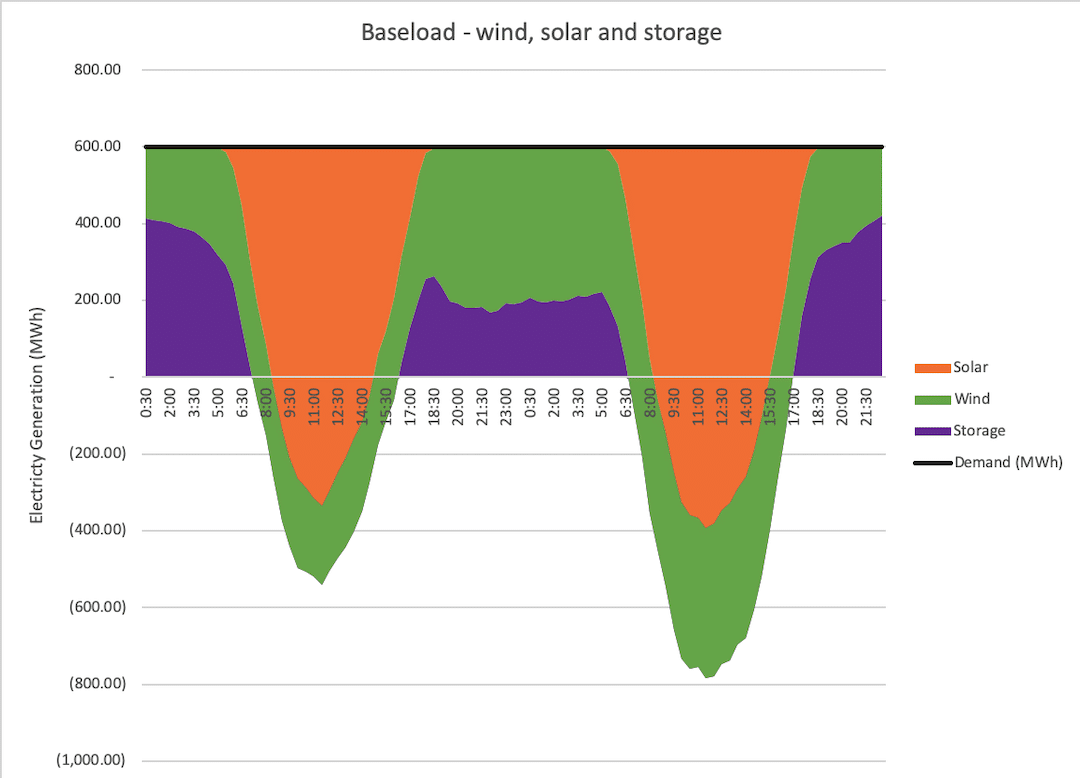
- New wind capacity - 2,141MW
- New Solar PV capacity - 2,098MW
- Total new capacity - 4,240MW
- Average output per day - 28,000MWh
- New storage energy capacity - 14,000MWh
- New storage power capacity - 845MW
A slightly lower requirement than load following, the baseload scenario would have a levelised cost of electricity of around $102.63.
Meanwhile, our own modelling indicates a new Coldry-enabled HELE power station could produce electricity at around $50-$60MWh with CO2 reductions of 43% to 62% compared to traditional brown coal power generation.
Conclusion
Is Victoria's energy plan a leap of faith?
We think so.
There appears to be a systemic reliance on flawed assumptions, such as high capacity factors for wind and solar, stable supply and externalisation of network and firming costs.
It's unlikely we can sway energy policy to encourage the use of our Coldry technology to enable deployment of HELE power plants in Victoria.
As such, we're focused on developing our Coldry technology to support higher-value applications such as coal-enhance waste-to-diesel via integration with our recently acquired CDP-WTE technology.
We're also focused on the proposed upgrade of our Coldry High Volume Test Facility (HVTF) to support local businesses reliant on heat or steam to process their goods.
We're focused on practical, affordable solutions to our energy challenges.
Victoria's energy plan is a 'leap of faith'
2 Sept 2019 | AFR | Angela Macdonald-Smith and Aaron Patrick
Victoria’s aggressive wind and solar push will shut down coal power stations and could send electricity prices skyrocketing, EnergyAustralia has bluntly told the state Labor government.
In a warning that the rapid adoption of renewable energy could spread power grid instability from South Australia to Victoria, EnergyAustralia said the Victorian government was going to force the Yallourn coal power station in Gippsland to close before its 2032 end-of-life date and likely shut other coal plants too.
Read more ($): Victoria's energy plan is a 'leap of faith'